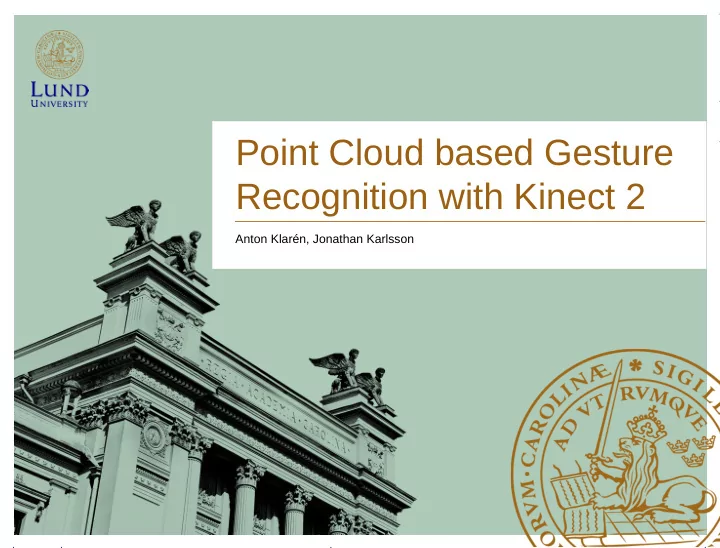

Point Cloud based Gesture Recognition with Kinect 2 Anton Klarén, Jonathan Karlsson
Kinect v2 2.5D Sensor (Depth) ● Time-of-flight sensor ● Full HD color camera ● 4-microphone array ● 30+ frame rate ● (Demo of Point Cloud)
Kinect 1 vs Kinect 2 Structured Light Time-of-flight Same principles as a radar, only on smaller distances and in 2 dimensions
ROS – Robot Operating System Not actually an operating system ● Framework for building software for robots, on top of ● ubuntu LTS. Contains many tools and utilities that are common in ● robotic-software. Its core consists of a publisher-subscriber network for ● interoperability.
Detecting People Classify subparts of the point cloud (Random Decision ● Forest) Smooth classifications and clustering (Mean-shift) ● Try to fit a skeleton to the data, score skeleton based on ● ideal skeleton, select highest scoring Grow region from skeleton to extract the person ● (Approximated floodfill)
Random Decision Forest Uses the concepts of Machine Learning and Regression ● Forest – Consists of multiple trees that all gets a vote; a ● vote consists of a probability distribution of the confidence score Merge votes from all trees and return the top candidate ● Random – Too many possible questions, take a random ● subset Fast and effective ●
Random Decision Forest
Mean Shift The objective is to find the densest region of a particular ● segment This is done with a sliding window that moves towards ● the mass-center (mean) Used to smooth the categorizations into segments ●
Approximated floodfill Perform edge detection on the depth data ● Groups segments by depth by ”filling” ● Used to extract interesting regions by masking with the ● filled regions
Mean Shift + Floodfill
Skeleton Fitting Start from a root node ● Find closest segment of child nodes ● Continue recursively until leaf nodes are found ● Discard improbable skeletons based on a score ●
Skeleton Fitting (Demo Skeleton)
Recognizing Gestures AdaBoost (Adaptive Boosting – Classifier) ● Based on linear regression ● Less susceptible to overfitting than other similar ● methods Works with many dimensions (feature space) ● Can be parallelized over dimensions ● Example input: Joint positions, limb angle, etc.. ●
Recognizing Gestures Random Forest Regression (RFR) ● Digests classifications from AdaBoost ● Emits classified gestures ● “ ” A random forest is a meta estimator that fits a number of classifying decision trees on various sub-samples of the dataset and use averaging to improve the predictive accuracy and control over-fitting. - Scikit-Learn developers
Future Improvements Implement AdaBoost and RFR ● Perform additional processing on hand-”blobs” to extract ● finger position Move parallelizable calculations to GPU to increase ● performance (> 3 fps) Tweak parameters and try with different hardware ●
Recommend
More recommend